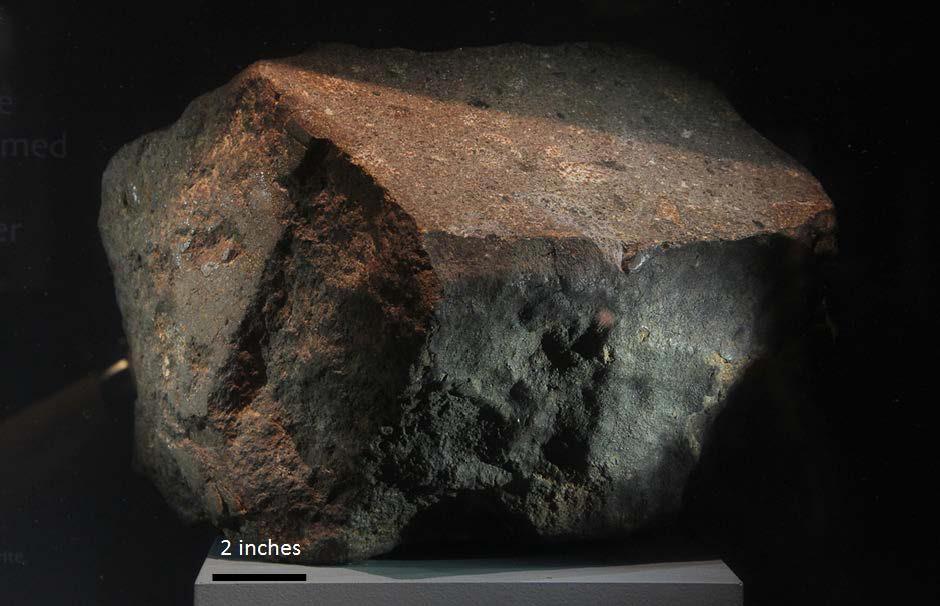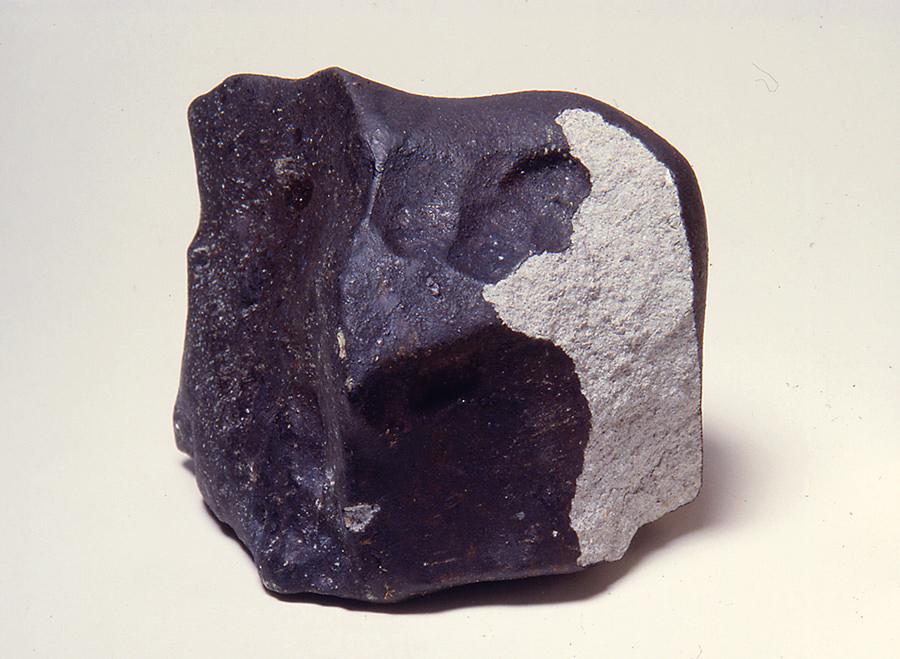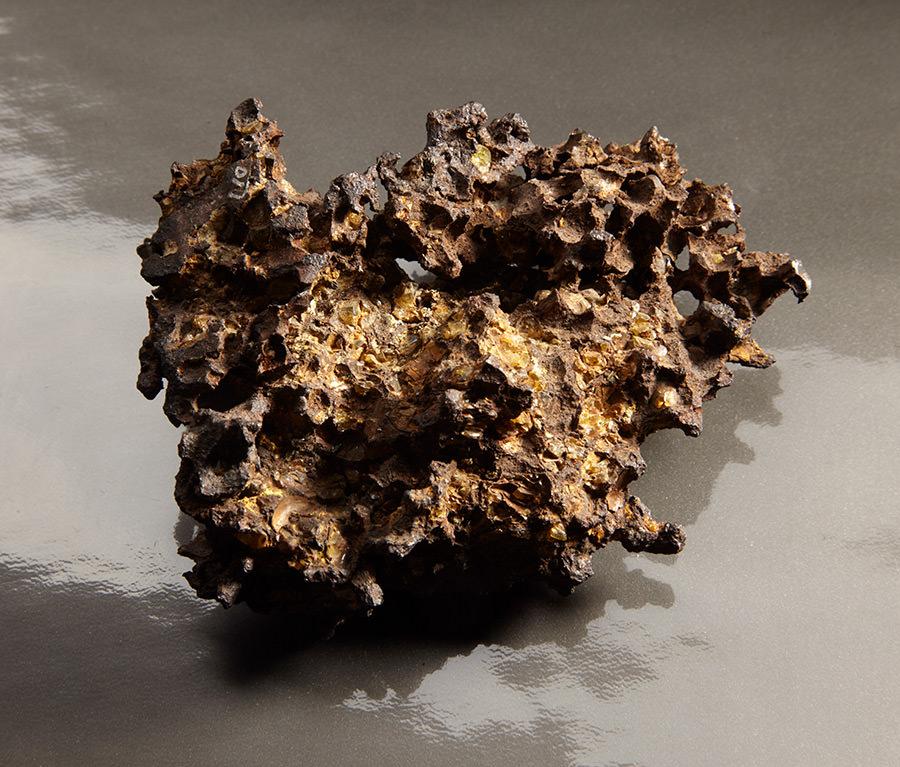Although thousands of meteorites fall to Earth each year, only 5 to 10 are immediately recovered. Any witnessed meteorite fall, anywhere, is a remarkable event.
Early in the morning of December 14, 1807, loud explosions were heard over Weston, Connecticut.
The Wethersfield (1982) meteorite, at about 9:17 pm on November 8, 1982, was the second meteorite to fall in the town of Wethersfield, Connecticut. The first happened on April 7, 1971.
In the spring of 2013 there was another meteorite fall that struck two Connecticut homes. The first fragment was found in Wolcott on April 19, 2013. The second piece from the same fall was found three-quarters of a mile (about 1.2 kilometers) west in Waterbury on May 8, 2013.
In Europe I had become acquainted with meteorites and the phenomena that usually attend their fall…. I did not dream of being favored by an event of this kind in my own vicinity and occurring on a scale truly magnificent.
— Benjamin Silliman, Sr., Silliman Family Papers (MS 450), Yale University Library
At 6:30 on the morning of December 14, 1807, a blazing fireball about two-thirds the size of the moon was seen traveling southward by early risers in Vermont and Massachusetts. Three loud explosions were heard over the town of Weston in Fairfield County, Connecticut.
Two or three days later Benjamin Silliman at Yale heard of it and with a colleague, James L. Kingsley, went to investigate, visiting everywhere stones had been reported and interviewing eyewitnesses. Fragments had fallen in at least 6 places. Several large pieces, including one of about 200 pounds (91 kilograms), had smashed on landing and others were smashed by the finders:
Strongly impressed with the idea that these stones contained gold and silver, they subjected them to all the tortures of ancient alchemy, and the goldsmith’s crucible, the forge, and the blacksmith’s anvil, were employed in vain to elicit riches which existed only in the imagination.
— Benjamin Silliman and James L. Kingsley in the Connecticut Herald, December 29, 1807
Silliman and Kingsley came away with “a considerable number of specimens.” Their account in the Connecticut Herald gave a detailed description of the fireball, the explosions heard more than 40 miles (64 kilometers) away, and the fall of the stones. It was quickly reprinted and a revised version—with a chemical analysis of the meteorite by Silliman, the first to be performed in the United States and among the first few in the world—was read before the American Philosophical Society in March 1808 and published the following year.
Silliman’s luck was extraordinary. Fireballs had been seen in New England and other settled areas in the 17th and 18th centuries, but the fall of a single stone, or even of a few, would have gone unnoticed or reports disbelieved. It was only around 1800 that a few mineralogists and chemists in Europe had begun to realize that these stones and chunks of iron from the heavens were distinctly different from earthly rocks. Final proof came with the huge meteorite shower that occurred at L‘Aigle, France, in 1803. The sheer number of specimens—between 2,000 and 3,000—and respectable witnesses forced the scientific world to admit that stones do indeed fall from the sky.
Silliman therefore became the first active American participant in the early development of the field of meteoritics. He presented pieces of the Weston meteorite to important friends and to scientific institutions. Some eventually found their way into museum collections around the world, thereby ensuring their preservation. Of the approximately 350 pounds (160 kilograms) that fell, less than 50 pounds (23 kilograms) can now be accounted for. Much of the rest undoubtedly gathered dust on 19th century Connecticut mantelpieces before being thrown away.
The largest and only unbroken stone of the Weston fall, weighing 36.5 pounds (16.5 kilograms) when recovered, was found some days after Silliman and Kingsley had spent several fruitless hours hunting for it. Its owner insisted on putting it up for sale and it was purchased by George Gibbs III for his large and famous collection of minerals. Silliman finally acquired this stone when the Gibbs Cabinet came to Yale in 1825. The largest unbroken specimen (28.2 pounds; 12.8 kilograms) is the largest known piece of the Weston meteorite and is at the core of the Yale Peabody Museum collection.
Adapted from “The Peabody Museum Meteorite Collection: A Historic Account” by Barbara L. Narendra. 1978. Discovery 13(1):10–23. © 1978 Yale Peabody Museum of Natural History. All rights reserved.
The fall of the Wethersfield meteorite on November 8, 1982, was extraordinary for 2 reasons. It was the second meteorite to fall in Wethersfield, Connecticut, in the incredibly short span of 11 years and, although meteorites rarely hit houses, it crashed through the roof of a home without injuring the occupants, as did the first Wethersfield meteorite on April 7, 1971.
For 3 or 4 seconds at about 9:17 pm, anyone looking at the sky and facing toward central Connecticut—in an area that included southern New Hampshire and Vermont, Massachusetts, New York State, and New Jersey, as well as Connecticut—caught sight of a ball of fire streaking across the sky. To some it was greenish with a long yellow tail; to others, orange-yellow or white. Many saw it seem to break into several pieces. Observers near Wethersfield saw the entire sky lit up as if by lightning and, after the fireball disappeared, heard loud reports like gunshots.
Wanda and Robert Donahue were watching television in their house on Church Street when they heard a loud, muffled thud that sounded as though a truck had come through the front door. They were stunned to find a hole in their living room ceiling, plaster debris, and the air filled with what they thought was smoke. A quick check upstairs showed a second hole in the roof.
Mr. Donahue telephoned the Wethersfield police to report an explosion. The Wethersfield Volunteer Fire Department was there within minutes. After a short period of general head-scratching and puzzlement, one of the firemen spotted a grapefruit-sized rock under the dining room table and correctly deduced that it was a meteorite. The “smoke” had been plaster dust from the ceiling.
Local newspapers and television stations monitoring the police telephone line were quick to pick up the story. Within a day or two, newspapers around the world had published front-page accounts.
The meteorite picked the right house to drop in on if it was looking for intellectually perceptive earthlings. The Donahues immediately allowed it to be borrowed for important tests and permitted scientists at several institutions to work on fragments. Faculty affiliate John Longhi in the Peabody Museum meteorite division studied its chemical composition and mineral structure using the electron microprobe in the Yale Department of Geology & Geophysics. The Donahues generously lent their meteorite for exhibition in early 1983 and in 1985 donated it to the Museum.
Adapted from “The Wethersfield Meteorite” by Barbara L. Narendra. 1983–1984. Discovery 17(1):27–28. © 1984 Yale Peabody Museum of Natural History. All rights reserved.
Two meteorites of the same fall struck Connecticut homes in 2013. The first came through the roof of Larry Beck’s house in Wolcott on the evening of April 19, 2013.
A few days later this first specimen, about the size of a baseball, was brought to the Yale Peabody Museum for examination by Collections Manager Stefan Nicolescu. The still warm extraterrestrial rock had all the hallmarks of a stony meteorite: charcoal black and very thin (less than 1 mm thick) fusion crust, smoothened edges, a somewhat rough surface, a light-colored interior, and ferromagnetism. A closer look at the fresh interior surface under a binocular microscope showed the chondrules (1 to 2 mm spherical pellets) typical of ordinary chondrite, the most common type of meteorite.
On May 8, 2013, another piece of this Wolcott meteorite was recovered from Waterbury resident Jay Langlois’ property, three-quarters of a mile (about 1.2 kilometers) west of the Wolcott house. This second meteorite punctured the gutter and was found buried in the lawn at the back of the house.
Meteoritics at the Peabody
The Yale Peabody Museum’s meteorite collection, begun by Benjamin Silliman the elder in the early years of the 19th century, is the oldest in the United States.
Yale’s collection was established with the fall of the Weston meteorite in 1807. This was the New World’s first witnessed fall of a meteorite after the arrival of European settlers. It was also the first time meteorite specimens were recovered and studied.
Silliman’s description of the fall—and his chemical analysis of the stony meteorite, the first in the United States—received much attention in the national and international press. Some of the 30 or so meteorites acquired by Silliman over the next half century came in mineral collections, most notably the Gibbs Collection, which contains pieces of the Krasnojarsk pallasite from Russia, the first of this rare type (over 170 out of more than 73,000 known meteorites - as of December 1, 2023 - are pallasites) of stony-iron meteorite discovered. This was the first meteorite to reveal a texture of long interwoven crystals that form during cooling, now known as the Widmanstätten pattern (although it was first discovered and published by William “Guglielmo” Thomson, an English mineralogist living in Italy; Widmanstätten never published his observations).
Today the Peabody’s meteorite collection contains an estimated 5,000 specimens (including 54 Antarctic meteorites) from around 3,600 localities worldwide, as well as a representative collection of tektites and other impact-related materials. The Red River meteorite—the largest acquired by Silliman and still the largest in the collection—is a 1,607-pound (729-kilogram) iron taken from Native American lands in Texas in 1808.
Benjamin Silliman, Jr. acquired for Yale and described several iron meteorites found in the United States. He exchanged specimens with the British Museum and the Mineralogical Museum of the University of Berlin, among others. Documentation of these early acquisitions is scanty. In 1867 George J. Brush became the first curator of mineralogy in the new Peabody Museum and for the next 100 years this post also curated the meteorite collection.
Named curator in 1874, while still in graduate school, Edward S. Dana (James D. Dana’s son and Benjamin Silliman the elder’s grandson) more than doubled the size of the collection in the next 46 years. Significant acquisitions were:
- Multiple specimens from the 3 great Iowa meteorite showers in Homestead (1875), Estherville (1879), and Forest City (1890). The Estherville meteorite—classified as mesosiderite—is a particular type of stony-iron meteorite. Its structure is unusual in that the iron is concentrated in nodules within the stone instead of dispersed throughout the mass in smaller particles, as in most mesosiderites.
- A 65-pound (29.5-kilogram) stone (Jerome) found in Kansas in 1894 by Handel T. Martin, a collector and preparator of fossils who had worked for O.C. Marsh.
- A very interesting fragment of the Canyon Diablo iron meteorite. Crammed with all sorts of meteoritic minerals, it also contains nanodiamonds—meaning microscopic. About 30 tons of this iron meteorite have been collected since 1891 from Native American lands near Meteor Crater in Arizona, USA. The original mass that collided with Earth 49,000 years ago was perhaps 50,000 tons, by some estimates. The Peabody’s second largest meteorite, Canyon Diablo measures about 2 feet (60 centimeters) across and weighs 813 pounds (369 kilograms).
- A large slice of the Gibeon meteorite that shows boundaries of 4 grains of iron.
- A 101-pound (46-kilogram) piece of the Brenham pallasite.
- A collection of about 100 meteorites made by Yale mathematics professor Hubert A. Newton.
Interest in the collection waned until later in the 20th century, when meteorites became prime source material for geochemists studying the history of our solar system. In 1960 the meteorite collection was separated from the mineral collection. Karl K. Turekian, appointed curator in 1966, added more than 200 meteorites and many impact-related objects to the collection, including in 1976 the former meteorite collection of the Brookhaven National Laboratory. In 2013 the mineralogy and meteorite collections were reunited in the Division of Mineralogy & Meteoritics under the curatorship of Jay J. Ague.
The same year, with the classification of the Wolcott meteorite by the Division of Mineralogy & Meteoritics, the Yale Peabody Museum became one of only 114 institutions worldwide (20 of them in the United States) accredited by the Nomenclature Committee of The Meteoritical Society as meteorite type specimen repositories.
For a more detailed history, see:


